Disclosure: We may earn commissions if you purchase products after clicking on a link from our site.
Do you wonder how do beavers build dams? Beavers are creative and industrious animals. They build dams using an intricate process that involves a series of strategic maneuvers where twigs and mud come together with astonishing precision.
Understanding the nuances of their engineering prowess can shed light on the crucial role these industrious creatures play in shaping their ecosystem. In this article, we discuss how beavers build dams and share the steps and processes used by beavers to build these impressive structures.
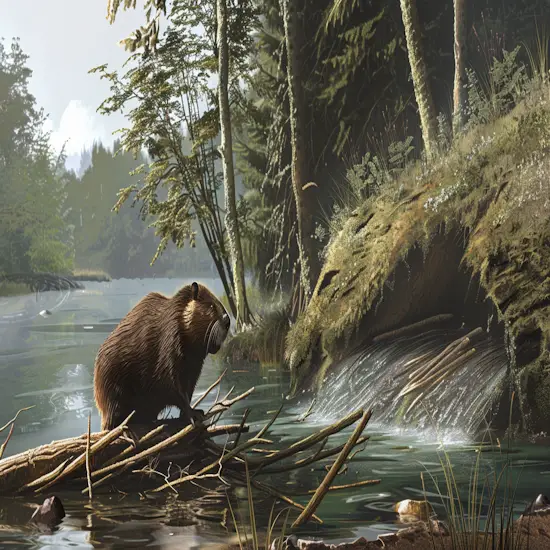
Table of Contents
Key Takeaways
- Beavers intertwine twigs in mud for stability.
- Layering mud and twigs ensures a strong foundation.
- Strategic construction controls water flow.
- Dams create pond environments for survival.
- Mud and twig placement showcases beavers’ skills.
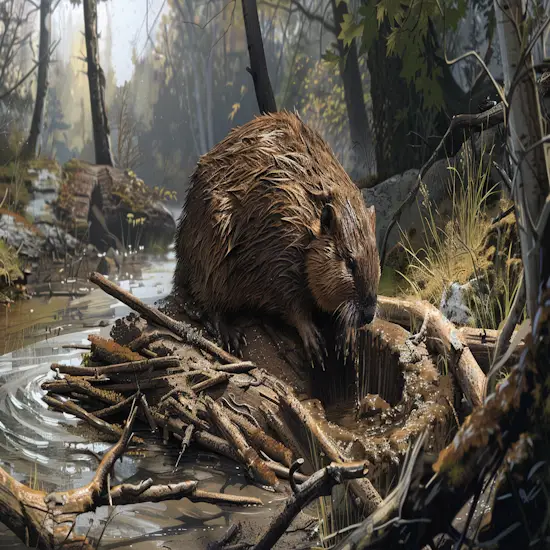
Reasons for Building Dams
Beavers build dams to protect their homes and families from potential threats. During winter, beavers store food at the bottom of their ponds, ensuring a food supply when resources are scarce.
Home Protection Strategy
To ensure the safety and protection of their homes and families, beavers strategically construct dams in their environment. These dams serve as an essential home protection strategy by creating a barrier against potential threats and providing a secure habitat for the beavers to thrive. Here is a breakdown of how beavers utilize dams for home protection:
| Home Protection Strategy | Description | Purpose |
|---|---|---|
| Underwater Entrances | Access to food storage | Easy retrieval of stored food |
| Slow Water Flow | Predators deterred | Protection from predators |
| Lodges in Water | Safety from land predators | Secure living environment |
| Barrier Construction | Shield against external dangers | Defense for the beaver family |
| Food Storage | Winter survival | Sustenance during harsh seasons |
Winter Food Storage
Utilizing strategic engineering, beaver dams play an essential role in securing winter food storage for these industrious herbivores. During winter, beaver ponds freeze, making it challenging for them to find food. To overcome this, beavers store young sapling branches at the bottom of the pond. They gather twigs, push them into the mud, and create underwater entrances to access the stored food easily.
Predator Defense Mechanism
With a keen awareness of potential threats, the construction of dams by beavers serves as an essential defense mechanism against predators. Beavers face dangers from predators like bears, wolves, eagles, and mountain lions.
By building dams, they create ponds that slow down water flow, protecting them from these predators. Beavers also construct lodges in water with underwater entrances to avoid being hunted.
The presence of a dam not only alters the landscape but also creates a barrier that deters predators from accessing the beavers’ living quarters. This predator defense mechanism showcases the strategic thinking and adaptability of beavers in ensuring their safety and survival in the wild.
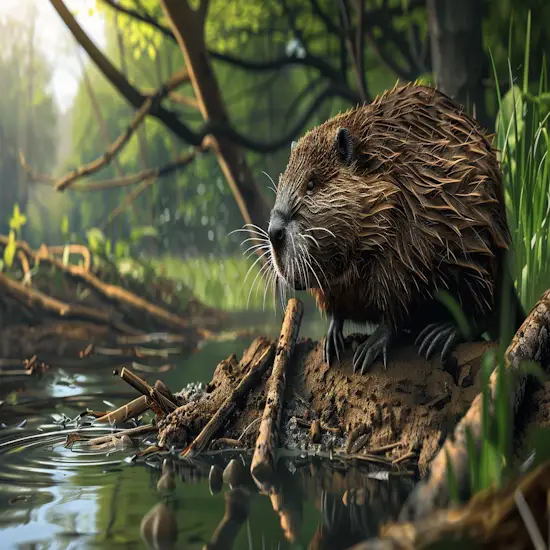
Predators and Protection Strategies
Predators pose a significant challenge to beavers. Bears, wolves, eagles, and mountain lions target them for food. Beavers construct lodges in water with underwater entrances to evade these predators effectively. Enhancing their defenses against these threats is vital for the survival of beaver populations in the wild.
Beaver Predation Challenges
Beavers face a variety of challenges from natural predators and have developed ingenious strategies to protect themselves and their families. Predators such as bears, wolves, eagles, and mountain lions pose threats to beavers. Wolves, in particular, prey on beavers and consume blueberries.
Humans also stand as significant predators of beavers. To counter these threats, beavers construct lodges in water with underwater entrances, providing them with a haven from predators. Additionally, the dams built by beavers create ponds that help slow down water flow, offering protection against predators.
Lodge Construction Techniques
To safeguard themselves from predators, beavers employ intricate techniques when constructing lodges in water, utilizing underwater entrances as a primary defense mechanism.
These underwater entrances are strategically designed to provide easy access for beavers while making it challenging for predators to enter.
Beavers use branches, sticks, and mud to build their lodges, creating a sturdy and safe structure hidden within the water.
By constructing their homes in this manner, beavers guarantee protection for themselves and their families from potential threats such as bears, wolves, eagles, and mountain lions.
The underwater entrances also serve as a clever way for beavers to access their stored food without leaving themselves vulnerable to predators lurking nearby.
Enhancing Predator Defenses
Enhancing their defenses against predators involves beavers utilizing strategic construction methods for their lodges and dams. Here are four ways beavers enhance their predator defenses:
- Underwater Entrances: Beavers create underwater entrances to their lodges, making it harder for predators to access them.
- Strategic Location: Beavers build their lodges in water bodies with underwater entrances, providing additional protection against predators.
- Dams as Protection: By constructing dams, beavers create ponds that slow down water flow, acting as a barrier against predators.
- Alert Systems: Beavers slap their tails on the water to warn others of approaching predators, allowing them to take evasive action.
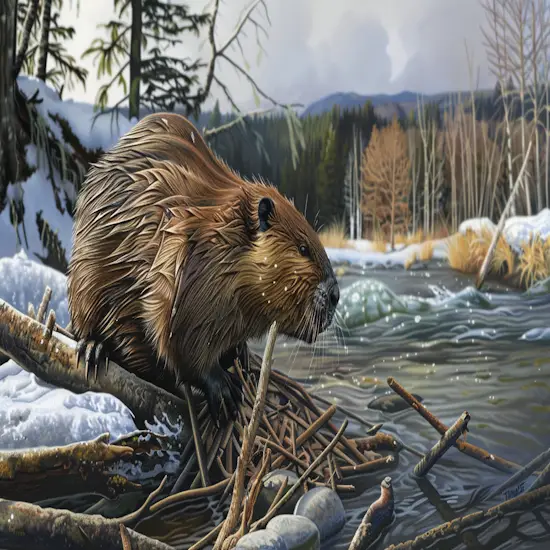
Steps in Dam Construction
You’re about to learn the step-by-step process of how beavers construct their dams. Selecting construction materials, utilizing tree cutting techniques, assembling the dam structure, and placing mud and twigs are key components in the beavers’ dam-building process.
Understanding these vital steps will give you insight into the impressive engineering skills of these industrious animals.
Selecting Construction Materials
When constructing a beaver dam, the first step involves carefully selecting appropriate materials to guarantee its stability and functionality. Here are some key considerations to keep in mind:
- Wood: Beavers primarily use wood from trees they’ve felled to build the main structure of the dam.
- Mud: Mud is essential for sealing gaps between branches and logs, ensuring the dam is watertight.
- Rocks: Beavers incorporate rocks into the dam to add weight and stability, especially in areas with strong water currents.
- Aquatic Plants: These plants are used to weave and reinforce the structure of the dam, providing additional strength and durability.
Tree Cutting Techniques
Using their sharp teeth and powerful jaws, beavers skillfully cut down trees to gather materials for constructing their dams. Beavers strategically choose trees close to water bodies, usually favoring trees like poplar, willow, and birch.
When a beaver targets a tree, it starts gnawing around the trunk, ensuring the tree falls towards the water. The beaver continues to chew until the tree topples, creating a splash as it hits the water.
Beavers then drag the fallen tree to the dam site, utilizing it as an essential component in the structure. This efficient tree-cutting process showcases the beavers’ engineering prowess and their ability to manipulate their environment to create intricate dam systems.
Assembling Dam Structure
To assemble the dam structure, beavers strategically gather branches, sticks, and mud to construct a sturdy barrier across the water. Here are the steps they follow:
- Branch Collection: Beavers select suitable branches and sticks from nearby trees and shrubs, ensuring they’re strong and flexible.
- Arrangement: They place the branches in a crisscross pattern, weaving them together tightly to form a solid base for the dam.
- Mud Application: Mud is gathered and layered between the branches to fill any gaps and reinforce the structure.
- Compaction: Beavers use their paws and bodies to compact the mud, ensuring the dam is strong and watertight.
Mud and Twig Placement
In beaver dam construction, the strategic placement of mud and twigs plays a crucial role in reinforcing the barrier across the water. Beavers meticulously gather twigs and sticks, weaving them together with mud to form a sturdy structure. They use mud to seal gaps and prevent water from seeping through the dam.
Twigs are intertwined within the mud, creating a strong foundation that can withstand the water pressure. By layering mud and twigs strategically, beavers guarantee the dam’s stability and durability. This method of construction allows the dam to effectively control water flow and create the necessary pond environment for the beavers’ survival.
The careful placement of mud and twigs showcases the beavers’ engineering skills in creating a functional and secure habitat.
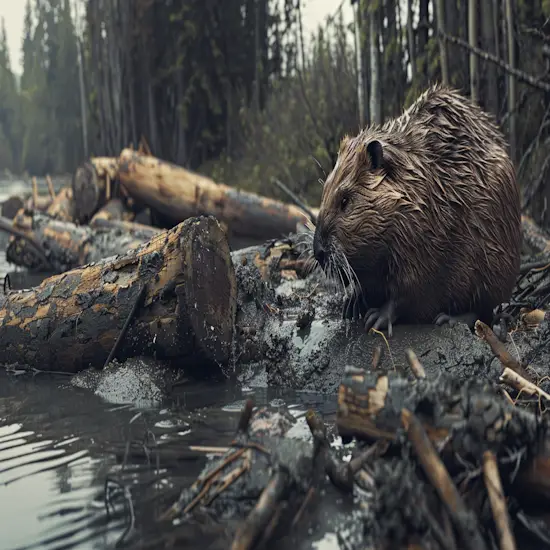
Environmental Impact of Dams
Beaver dams play an essential role in creating wetlands, which offer numerous benefits to the environment. These dams enhance biodiversity by providing habitats for a wide range of species. Additionally, they help reduce the risk of forest fires by maintaining moist environments.
Wetland Creation Benefits
How do beaver dams contribute to the creation of wetlands and their environmental benefits?
Beaver dams play a vital role in forming wetlands, which offer various advantages to the ecosystem. Here’s how these dams benefit the environment:
- Habitat Creation: Wetlands formed by beaver dams provide habitats for numerous species.
- Biodiversity Support: Wetlands support a wide range of plant and animal species, contributing to biodiversity.
- Water Quality Improvement: Wetlands filter and purify water, enhancing water quality in the surrounding areas.
- Flood Prevention: Wetlands help in absorbing excess water, reducing the risk of flooding in downstream areas.
Biodiversity Enhancement
Enhancing biodiversity, beaver dams play a significant role in supporting a variety of plant and animal species within their ecosystems. By creating wetlands through dam construction, beavers provide habitats for numerous organisms. These wetlands attract diverse wildlife, including birds, fish, amphibians, and insects.
The slow-moving water in beaver ponds supports aquatic plants and invertebrates, which in turn attract larger predators like otters and herons. Additionally, the wetlands created by beaver dams act as breeding grounds for many species, contributing to the overall richness of the ecosystem.
The presence of beavers and their dams helps increase biodiversity by fostering a complex web of interactions among different organisms, making them essential for maintaining healthy and thriving ecosystems.
Fire Risk Reduction
To reduce the risk of wildfires, the impact of beaver dams on the environment is vital for maintaining a healthy ecosystem. Here are four ways beaver dams help in fire risk reduction:
- Water Retention: Beaver dams slow water flow, creating ponds that serve as natural firebreaks.
- Wetland Creation: Dams lead to the formation of wetlands, which act as fire-resistant buffers.
- Biodiversity Support: Wetlands from beaver dams house diverse plant and animal species that contribute to ecosystem resilience.
- Improved Water Quality: Beaver dams filter sediment and pollutants, enhancing water quality and reducing fire hazards.
Beaver dams play an important role in mitigating fire risks, showcasing their significance beyond their immediate impacts on aquatic habitats.
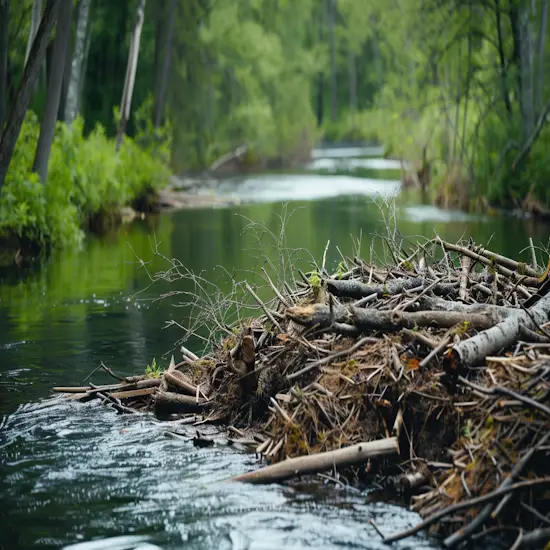
Coexisting With Beavers
To coexist peacefully with beavers, consider installing wire mesh fences around trees to prevent damage. Installing beaver baffles can help maintain water flow without harming wetlands. Implementing property protection strategies can help you live harmoniously with these industrious creatures.
Preventing Beaver Tree Damage
By installing wire mesh fences around trees, you can effectively prevent beavers from causing damage by cutting them down. Here are some tips to help you coexist peacefully with these industrious creatures:
- Protect Trees: Use wire mesh or hardware cloth to create a barrier around the base of trees you want to safeguard.
- Choose Beaver-Resistant Trees: Plant species like birch, sycamore, or honey locust that beavers are less likely to target.
- Install Tree Wraps: Wrap tree trunks with metal flashing or plastic tree guards to deter beavers.
- Maintain a Buffer Zone: Create a buffer area around your property by removing tempting plants, ensuring beavers are less likely to venture close to your trees.
Installing Beaver Baffles
Prevent beavers from blocking water flow and causing flooding by installing beaver baffles along waterways. Beaver baffles are devices designed to regulate water levels while allowing fish and other aquatic species to move freely.
These structures can be installed in culverts, pipes, or dams to control water flow without impeding beavers’ activities. By strategically placing baffles, you can maintain the ecological balance of wetlands created by beavers while minimizing the risk of flooding to nearby properties.
Beavers can continue to thrive in their habitats, and humans can coexist with these industrious animals by implementing these simple yet effective solutions. Beaver baffles offer a practical way to manage water flow and protect both beavers and human infrastructure.
Property Protection Strategies
Implement practical strategies to safeguard your property while coexisting harmoniously with beavers. Here are some effective ways to protect your property from beaver damage:
- Fencing: Install wire mesh fences around trees to prevent beavers from cutting them down.
- Beaver Baffles: Use beaver baffles to allow water flow without harming wetlands.
- Property Damage Mitigation: Find ways to mitigate property damage caused by beavers.
- Coexistence Strategies: Implement measures to prevent property damage while respecting beavers’ habitat.
The Bottom Line
If you want to learn how do beavers build dams, then this article provides the information to educate on the process. It explains the process and gives the steps and processes used by beavers to build dams.
The process beavers use to build dams is like a well-oiled machine in action. Their strategic construction not only protects them from predators but also benefits the environment in numerous ways.
If you want to learn how to hunt beavers or be more successful when hunting beavers, then read the articles how to hunt beavers, how to hunt beavers at night, how to attract beavers, and how are beavers important to Canada.
